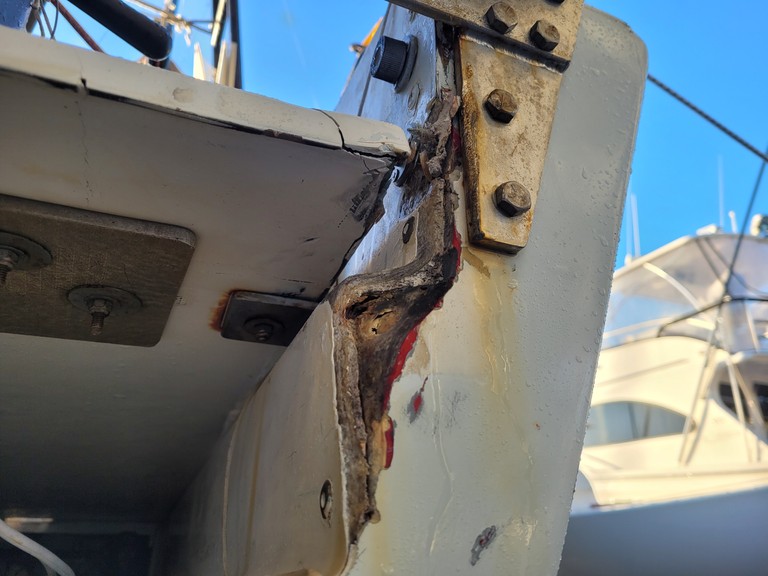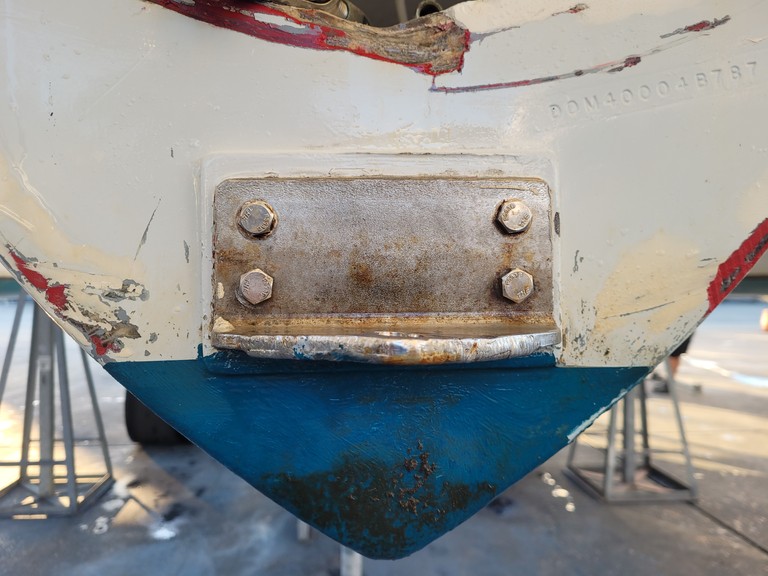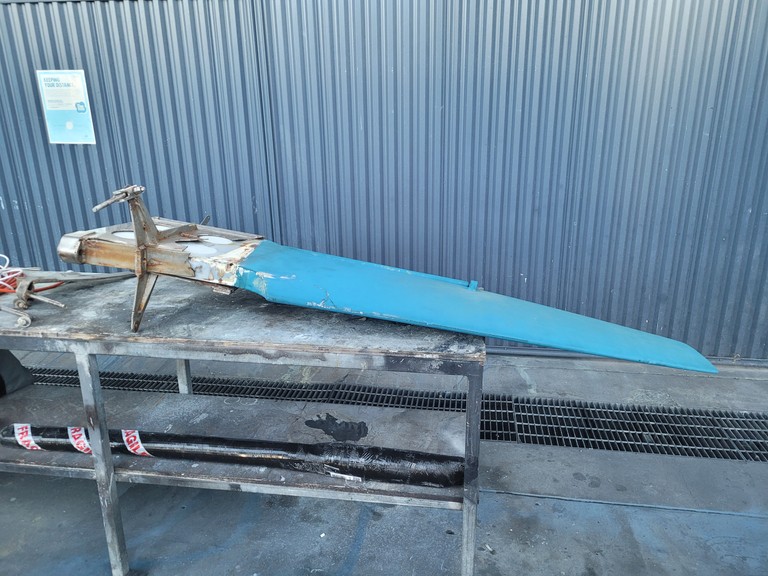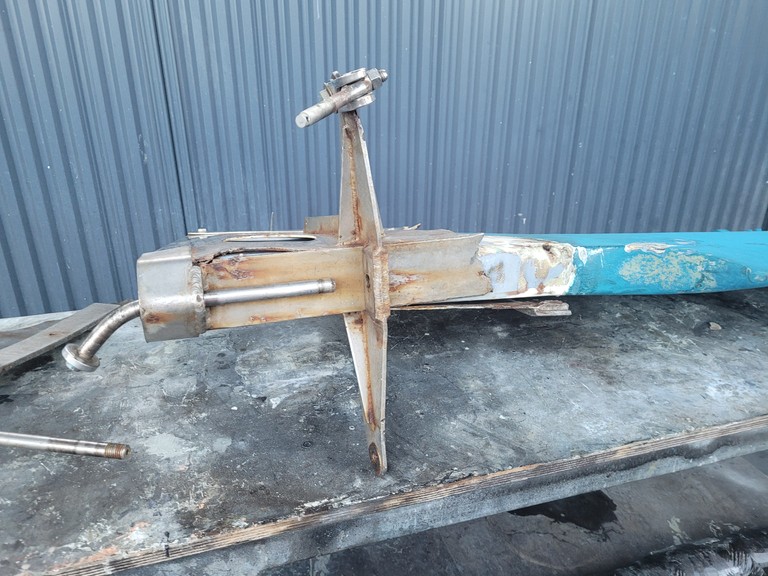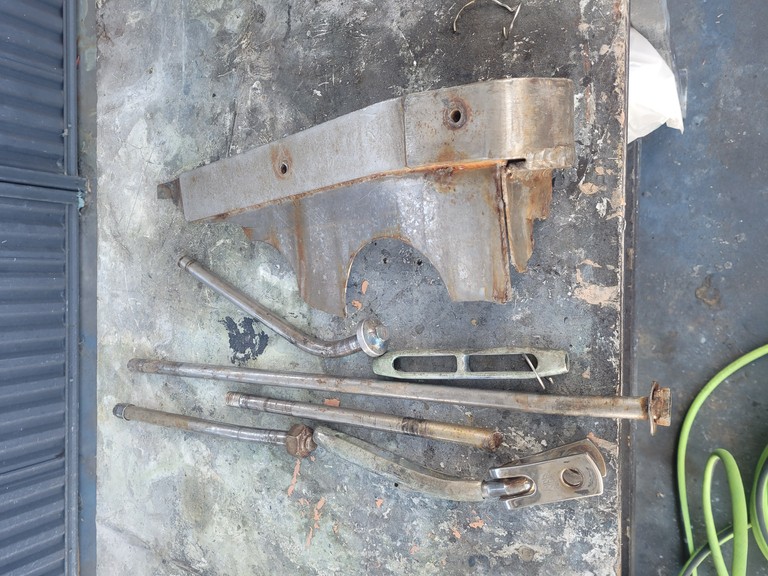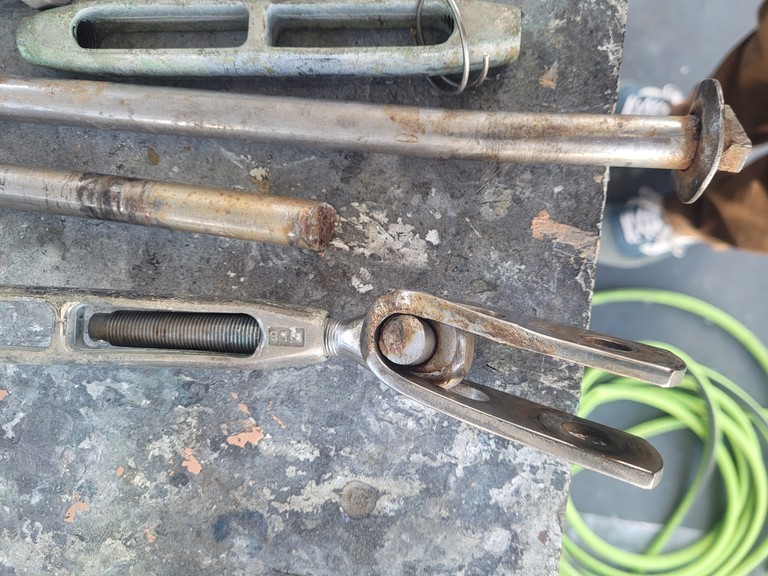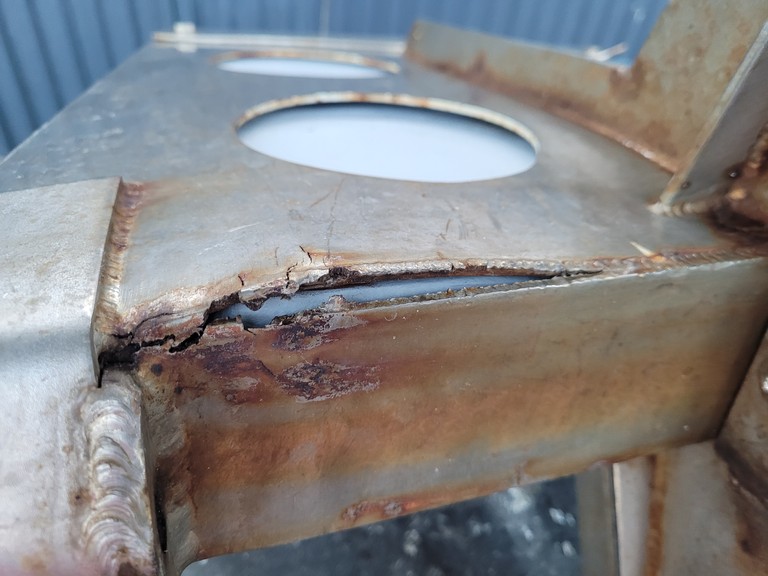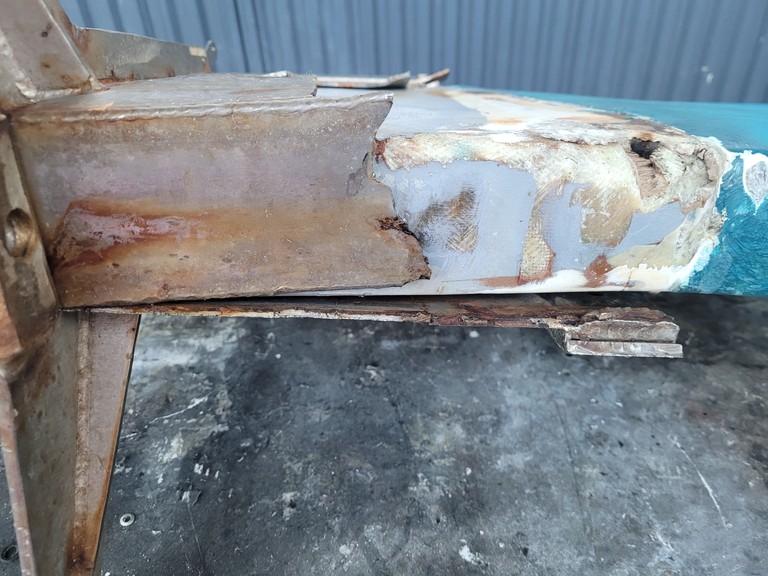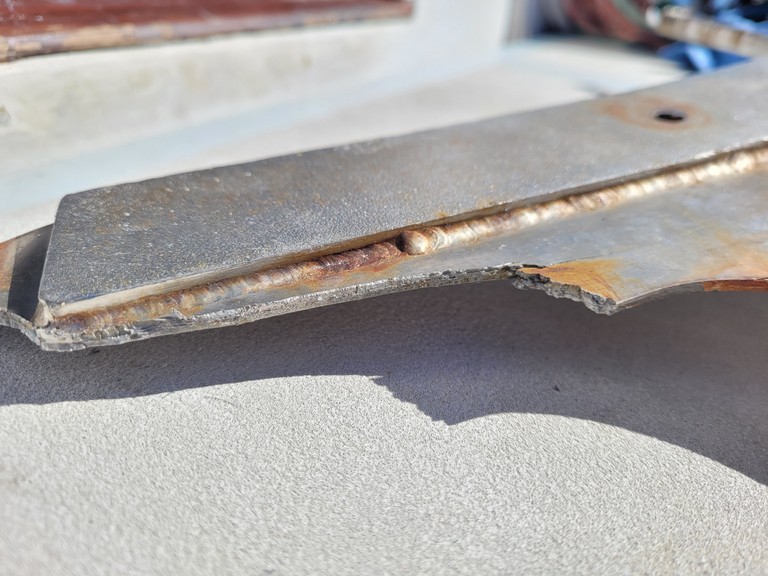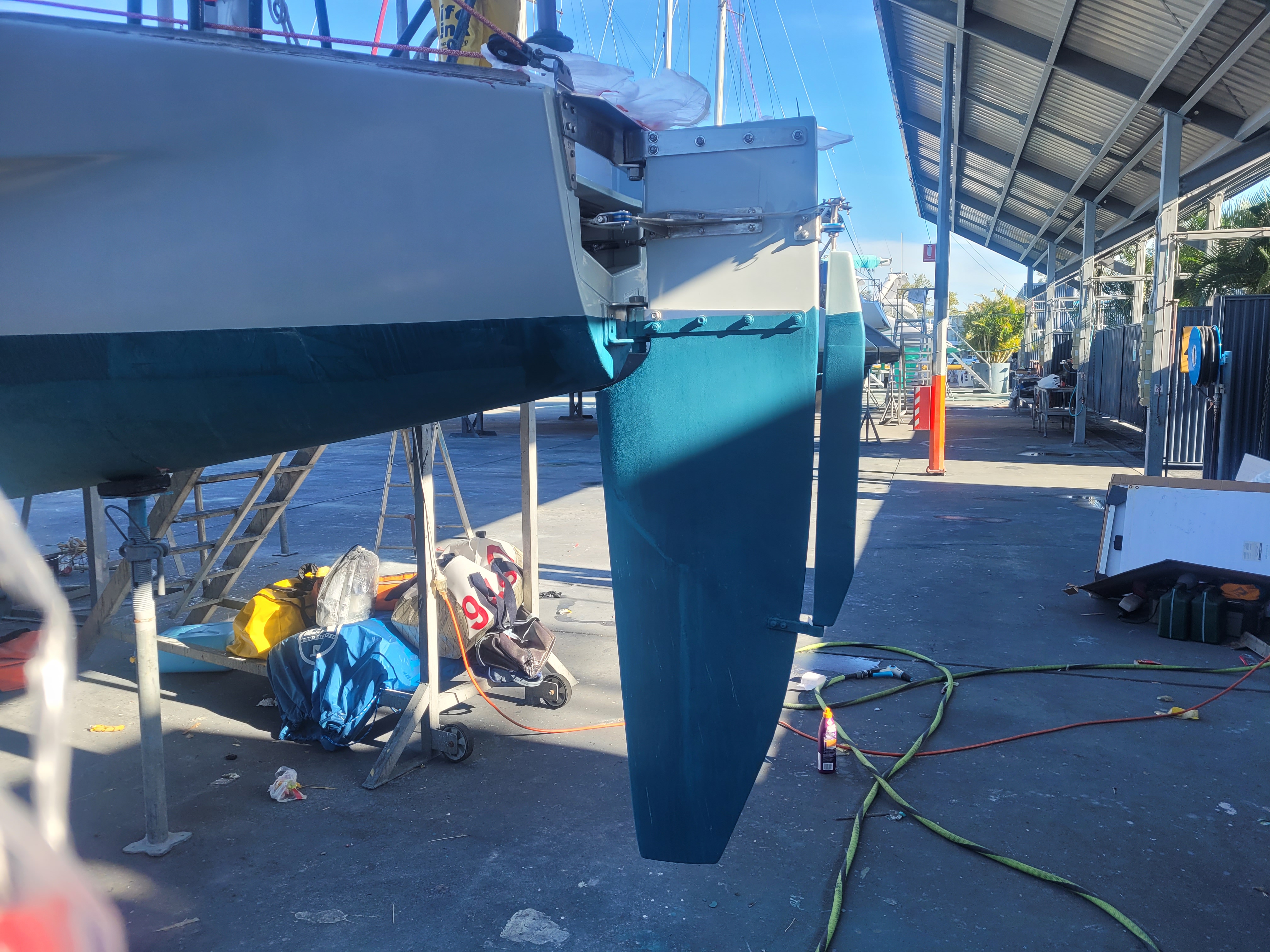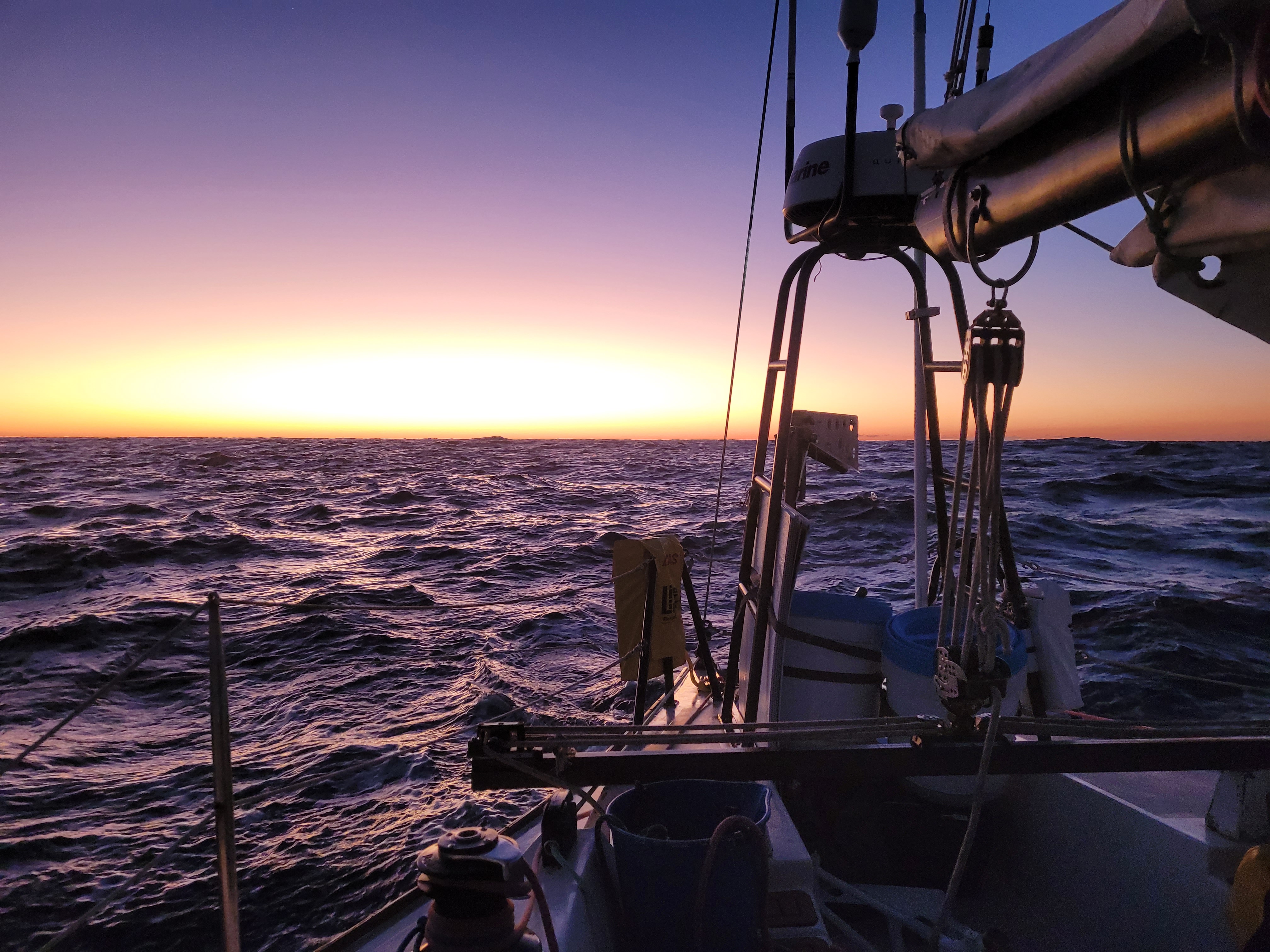Shit Happens (part 2)
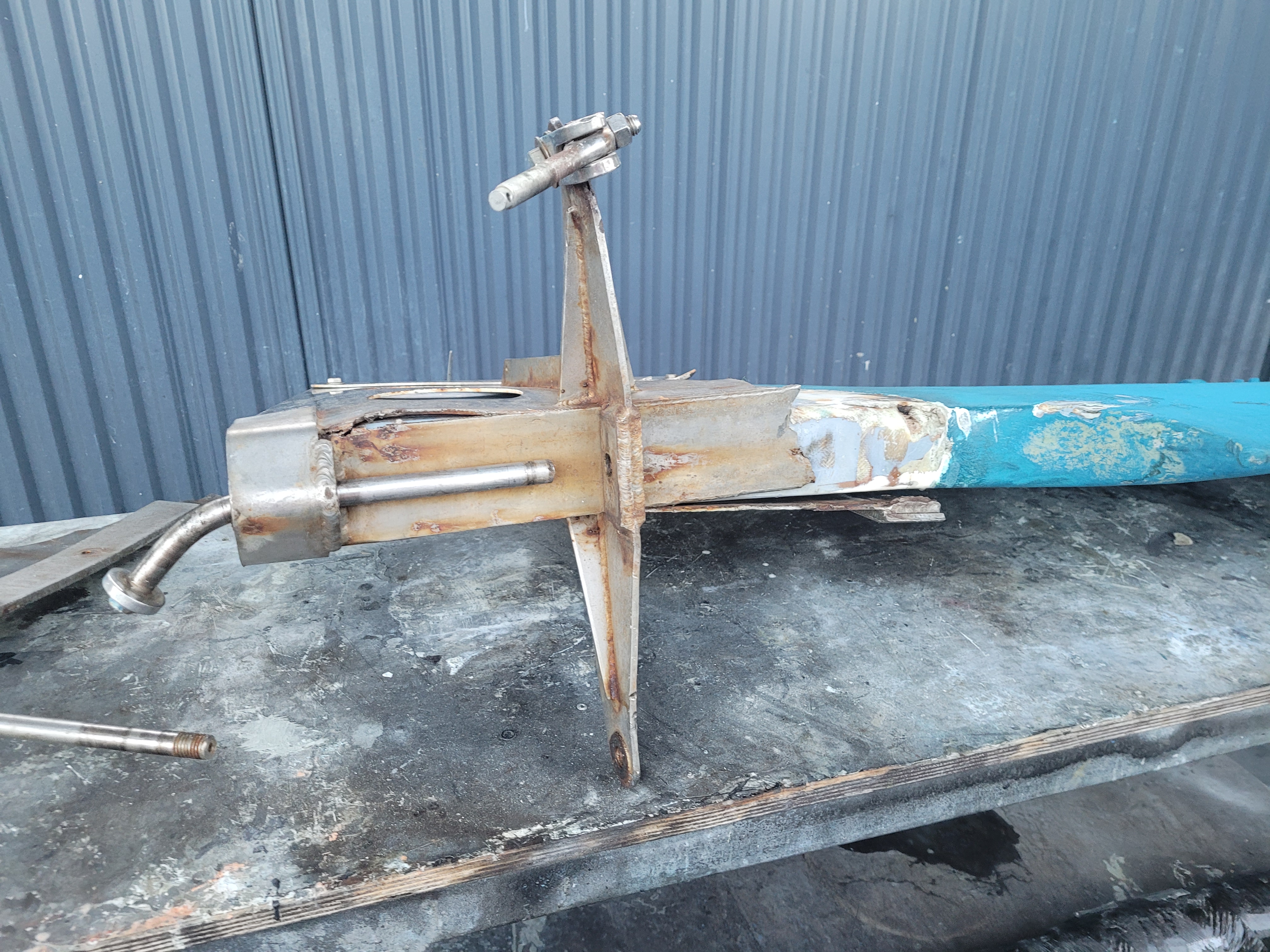
This one is a more technical post on two topics: first, what happened and what broke, and my best analysis on why; second, on the tow setup and how it was designed - since the tow held up well, I'm hoping that will be useful information for anyone finding themselves in a similar situation.
Part 1: Root Cause Analysis
In the information security world, breaches (i.e. failures of a security system) are, once mitigated, usually subject to a process called Root Cause Analysis (RCA) to determine what went wrong. I want to apply a similar method to the rudder failure on Iria.
What failed:
It appears the rudder cage fatigued away along a diagonal crack along the lower third of the cage. That failure led to lateral stress on the metal pin that holds the rudder onto the metal attachment points on the stern. That pin bent about 60-70 degrees just below its center, and eventually broke in half due to the lateral force on it during the tow.
Here's some photos of the failed parts and resulting damage:
Why it failed:
As with any breakage, it's hard to determine a specific singular cause, and it's likely that multiple problems combined to contribute to the failure. So far, I can identify three problems that likely contributed. Before getting into those, I want to underscore what was inspected on the rudder before departure.
Rudder inspection before departing was done by myself and by a professional in the boatyard with extensive experience with multihull rudders. Both identified some cosmetic issues (surface rust on some parts of the metal rudder cage) but no apparent structural issues. There was also a small amount of play in the rudder pin assembly where it went through the metal attachment points on the stern - not enough to pose a threat, but enough to rattle a bit at anchor. Based on how the rudder failed, I do not believe that play was part of the cause.
Contributing problem one: excessive water entry in the bow compartments.
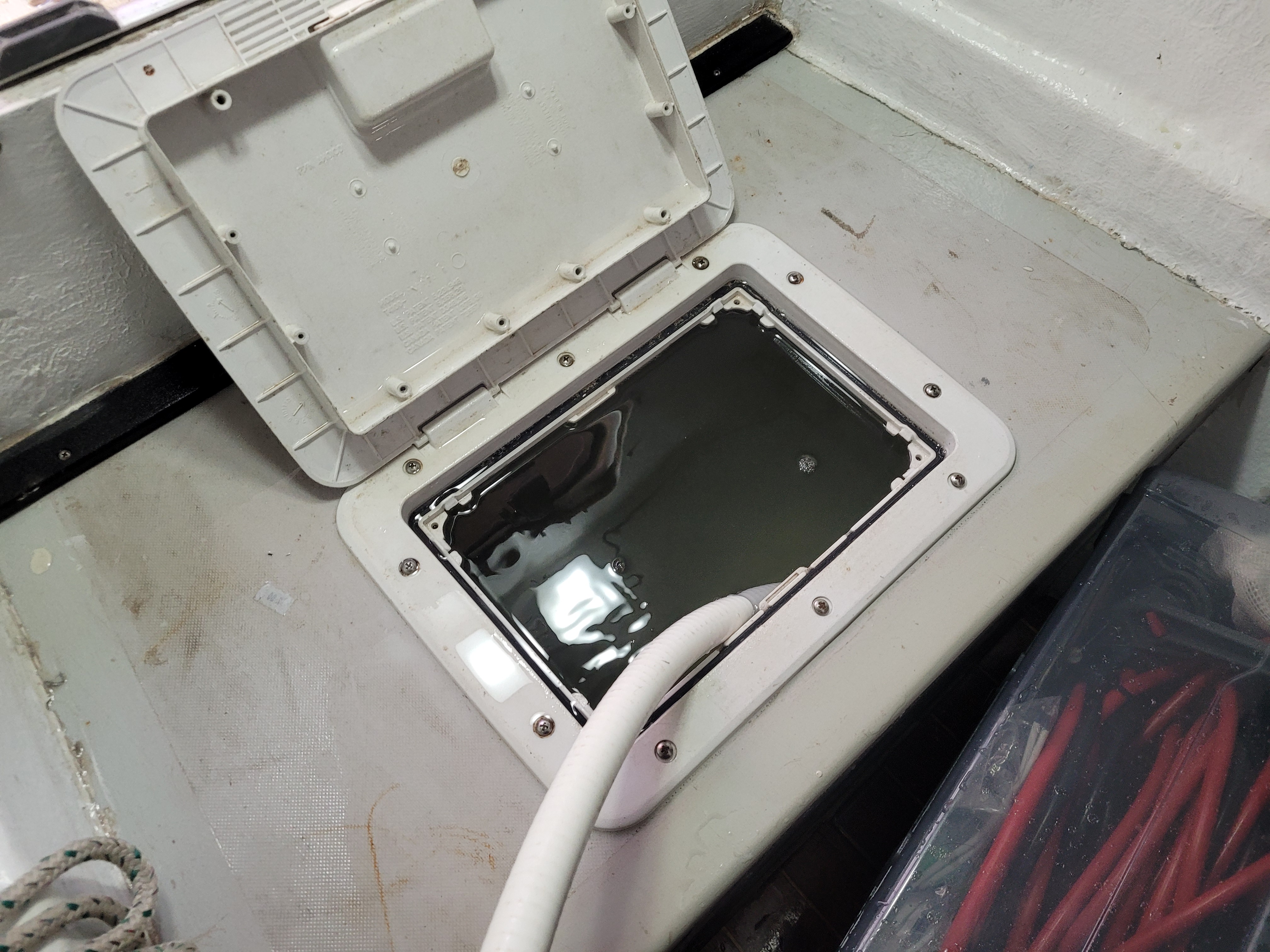
Before leaving, we did not have time to fully seal the windlass. Since it rides fairly high and somewhat back on the bow, I expected this would not lead to much water entry, and coastal shakedown sails had shown only a few drops of water entering through that hole under normal sailing conditions. This was not the case in the seas we experienced. After getting back to the dock, it was apparent that many gallons of water had come in through that hole over time, as the main hull's bow was submerged occasionally in larger cross-swell. I suspect this excess weight in the bow increased stress on the rudder as the autopilot did its job (admirably!) at holding course in a confused sea state. This alone should not have caused a rudder cage failure, but I expect it increased the stress on the rudder due to the additional momentum from excess bow weight.
Contributing problem two: faulty steel in the rudder cage.
The rudder cage did not fail along a weld or along any of the areas showing surface rust. On inspection once back in port, the break was along a diagonal crack that had not been present before departure, and the steel in that broken cross-section looked badly crystallized. I strongly suspect this was due to manufacturing error in the rudder cage, which - combined with its relatively thin material - failed after repeated fatigue in the confused sea state.
Contributing problem three: excess speed in confused seas.
As noted in part 1, the boat was fairly difficult to slow down. It was not showing any signs of being over-powered (e.g. the leeward hull's bow was not submerging, steerage was fine and controlled until the rudder breakage, and the sails were not overpowering the rudder), but would catch the occasional wave from behind and/or gust from the beam, and would power off at speeds of up to 11-12 knots. In a calmer or more organized sea state, that speed would be no problem. The problem was that the confused seas combined with that speed led to signfiicant slamming, yawing, and rapid deceleration when a cross-wave was encountered. Increased speed also means greater forces on the rudder. This would have been exacerbated by the excess water in the bow as well. Dousing or deeper reefing of the mainsail may have reduced speed to a point where the rudder's faulty steel might have seen lower stresses and stayed within its structural limits. That all said, reducing speed might have only delayed this failure - leaving us further out at sea, further from help and vessels who could assist, and with further to go to get back to safe harbor.
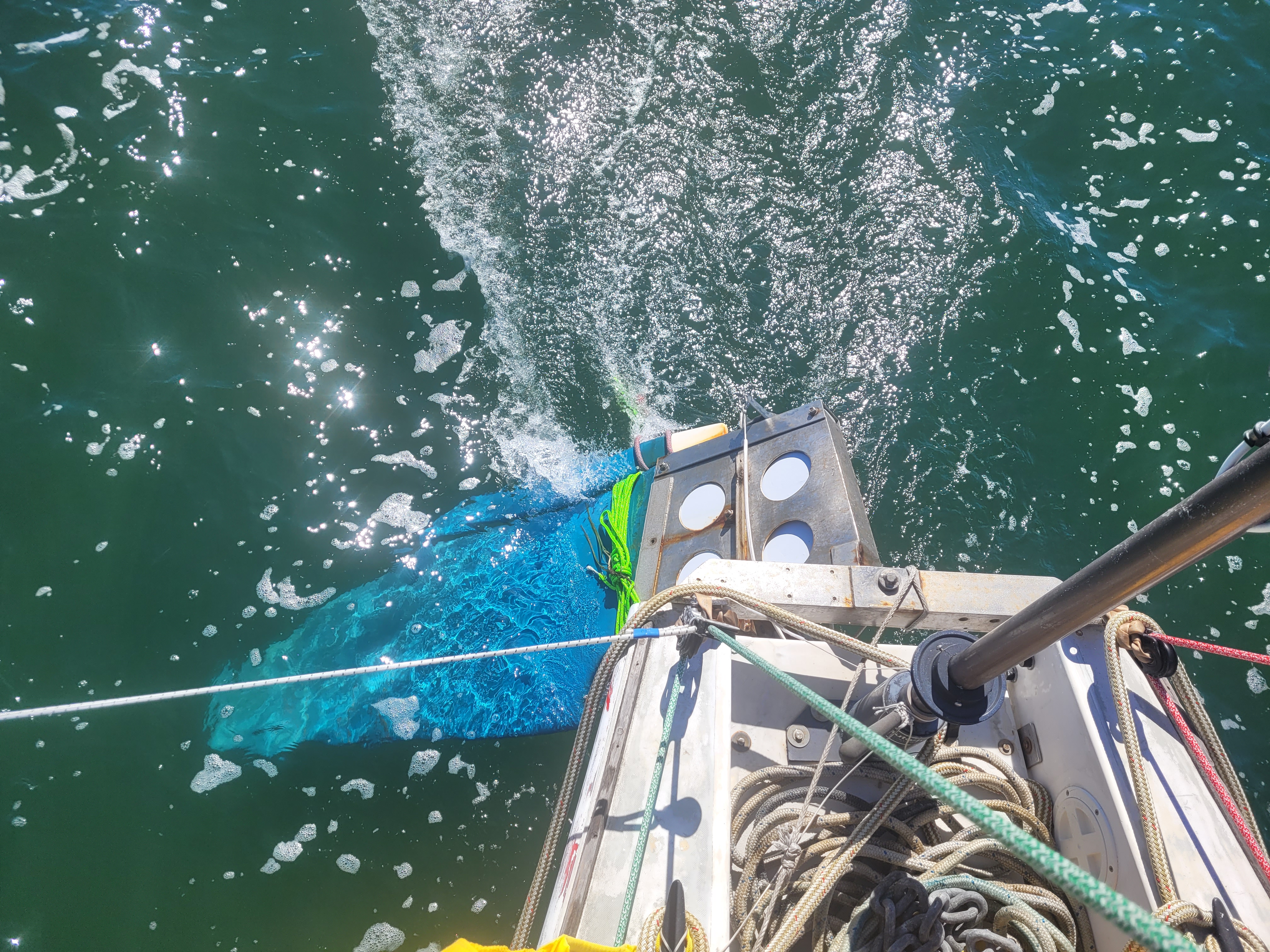
All of this, of course, is informed guesswork on my part. It's possible that the rudder would have failed along the same fault-line even at slower speeds and/or without the added water-weight in the main bow section. I'm hoping to have the rudder cage remnants examined by a professional steel fabrication shop to get a more informed opinion on its state, and will update this post if that reveals any useful new information.
One important note: I carry a lot of repair kit and spare parts aboard, including everything necessary to effect emergency steering under several different parts-failures. The jammed rudder pin was what rendered this particular breakage impossible to jury-rig in the sea state we had at the time, since it both prevented any steering effort with that rudder and made removing that rudder impossible until the pin eventually broke in two. With the advent of hindsight, I think that in a situation where "nearby boat can tow us back" wasn't an option, a repair or jury-rig would've eventually been possible, but not until the sea state calmed enough to work safely near the rudder.
In sum:
What we did right:
- Pre-departure rudder inspection was thorough and revealed no issues
- Shakedown sail also revealed no rudder issues beyond minor noise at anchor in choppy conditions
- Slowing down overnight was helpful in the confused seas and gusty conditions
- Carried sufficient gear to rig a tow (and probably enough gear to effect a rudder jury-rig if necessary)
- Rudder was retained and is available to be repaired if possible
- Crew avoided injury while examining problem and while attempting a jury-rig repair
What we did wrong:
- Shakedown sail could have been longer and more thorough, as conditions offshore were more intense than those encountered in the shakedown sail
- Slowing down was not sufficiently successful to reduce speeds and subsequent rudder loads
- jury-rig repair was not secure enough to hold in anything but fairly calm conditions
- Rudder being retained prevented rigging a jury-rig steering system using the backup steering gear aboard
- Rudder spares stowed aboard did not include material to patch or temporarily reinforce the rudder cage
Part 2: Tow Line Setup and Technique
Iria is well-equipped for lying to a sea anchor or other high-stress bow lead, which proved essential in assuring a safe tow. I don't have any photos of the exact setup, as all hands were full and busy getting the tow set up. You can see the port bridle line lead at least in this image:
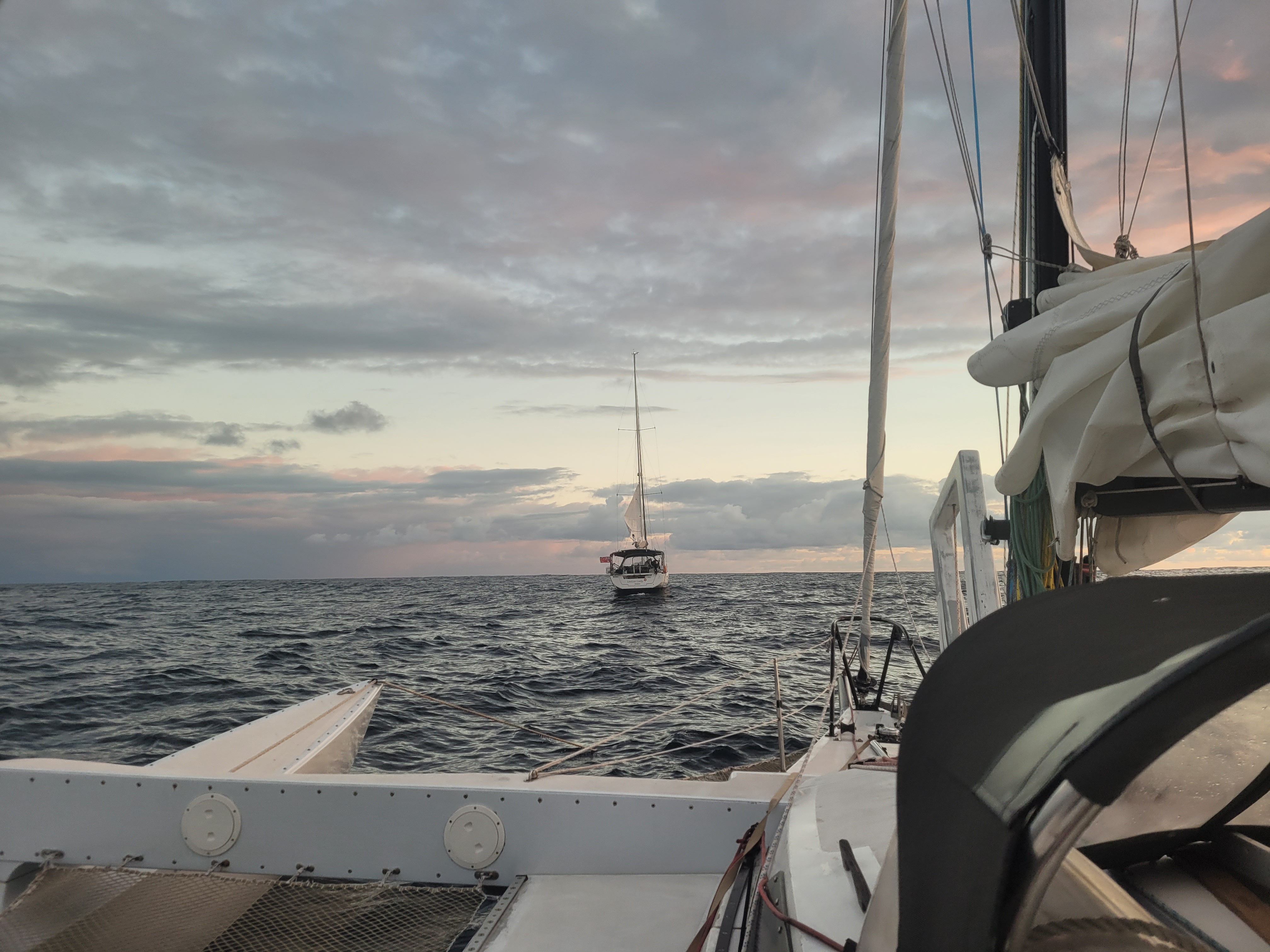
On our end, the tow setup in order of closest to the boat to farthest consisted of:
- strong anchor/sea-anchor chainplates in the outer part of the forward beam, designed to hold the full weight of the vessel and then some.
- heavy 3-strand nylon lines running from those chainplates through blocks on the outer hull bows, extending about 12 feet (3.6m) past the bow and ending in metal thimbles.
- shackles connecting those metal thimble-eyes to an equally heavy but basically brand-new 3-strand nylon anchor bridle on each side, spliced together to a central point also ending in a metal thimble.
- a heavy shackle connecting that metal thimble on the bridle's end to a heavy duty swivel taken from the vessel's drogue kit and rated to several times the vessel's weight.
- the swivel connecting to a roughly 400 foot (120m) drogue line made of heavy double-braid nylon. This formed the main towing line, and also taken from the vessel's drogue kit.
- on the tow vessel's end, this heavy drogue line connected to an 18mm dock line about 52 feet (16m) in length, double on itself and tied off in the center to form the tow vessel's bridle.
This setup held up without any noticeable chafe or damage at any point, through a first 24-36 hours of confused seas and a subsequent ~48 hours of lighter seas, over the full ~160 nautical mile tow. (I'm honestly pretty amazed by this.) The only issue was electronics error, resulting in the towing vessel very lightly wrapping its prop in the tow line or bridle (unsure). This was thankfully cleared at the calmest moment in the trip, using a dive "hookah" and without cutting any involved line. The only other item that needed tending or adjustment were two of the shackles on our beam chainplates, which had slightly loosened. All other shackles were 100% fine and tight on our arrival and tow line disassembly.
What we did right:
- Strong points on the towed vessel bow were used to connect the line
- The line was of sufficient length to give good distance between the vessels in tow formation
- The line had sufficient stretch to avoid any noticeable shock-loading on either vessel
- The swivel likely prevented twisting of either vessel's bridle system
- The towing vessel's stern cleats were of sufficient strength to withstand the towing loads
- both vessel's crews maintained a 24-hour watch system and actively monitored vessel attitude and tow line condition
- all aboard were tethered in, and jacklines allowed us to safely move around on deck to check the tow line or rudder.
- close radio coordination between the vessels was maintained at all times
- speed of the tow was kept low, reducing stress and loads on both vessels and the tow line
What we did wrong:
- Shackles in the tow line system could have become dangerous projectiles if the tow line broke under load, and are never a good idea.
- electronics error on the towing vessel nearly caused a serious problem, briefly disabling both vessels.
- towing with the disabled rudder attached resulted in moderate damage to the towed vessel's stern, from grinding of the metal rudder parts against the fiberglass stern.
What we got lucky:
- The tow line was a correct length for the rougher seas of the first day or so of the tow to keep both vessels in a similar part of their respective seas, avoiding shock loads that can result from dissimilar wave positions on the two vessels
- the wrapped line was able to be untangled without cutting (likely due to the towing vessel's crew swiftly disengaging the engine once the wrap was apparent)
- seas subsided for most of the latter part of the tow, reducing stresses and allowing the towed vessel to briefly jury-rig its rudder to reduce hull damage
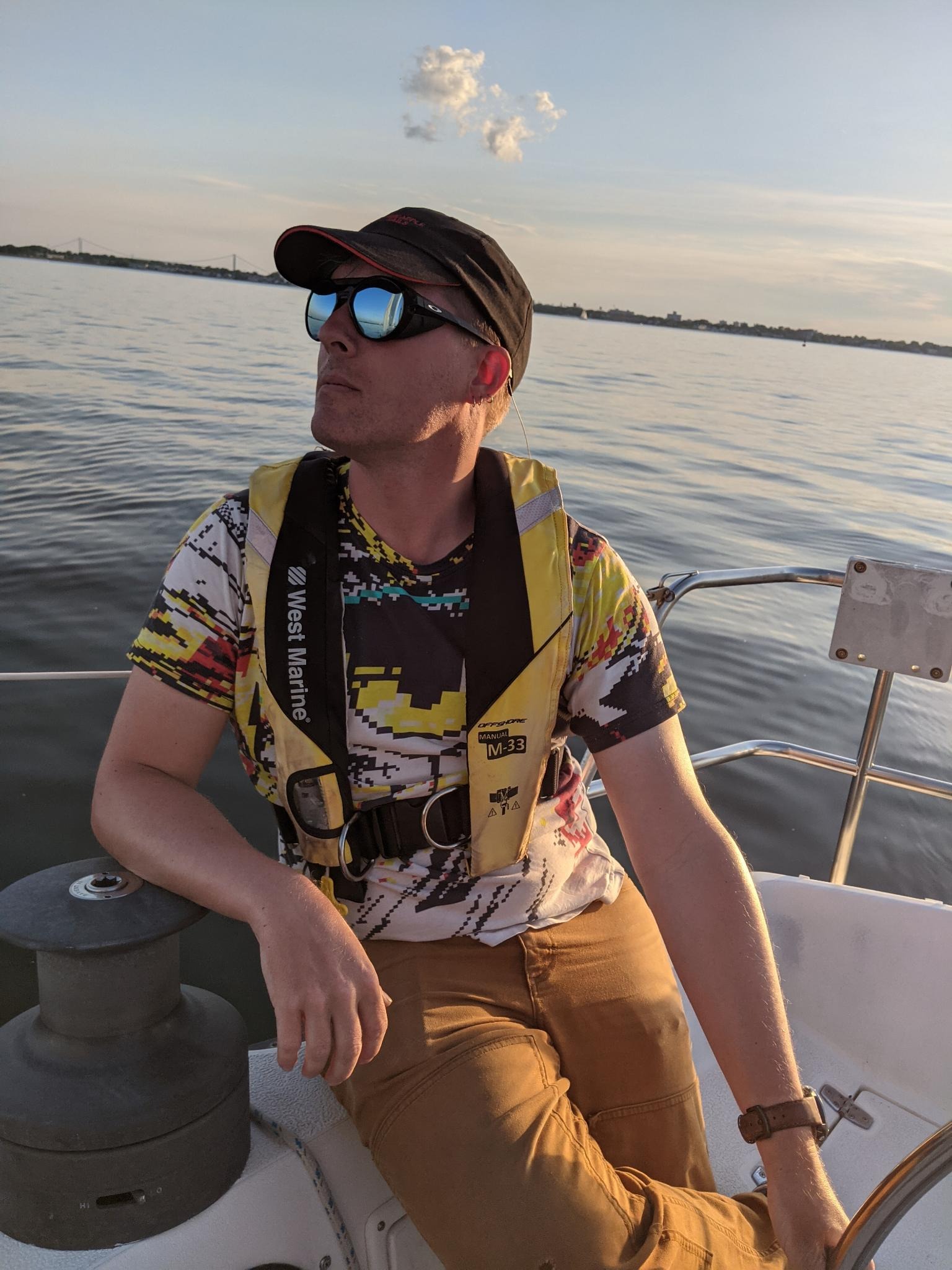 By
By 
